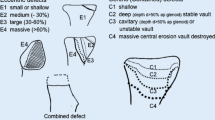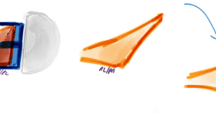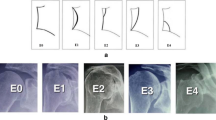Abstract
Introduction
Glenoid bone loss is a commonly encountered problem in complex primary and revision shoulder arthroplasty. Addressing glenoid bone loss is critical to avoid complications like early loosening, impingement, notching and instability. A large number of techniques like bone grafting using autograft or allograft, eccentric reaming, augmented base plates, patient-specific instrumentations and custom-made implants are available to tackle bone loss.
Materials and methods
We prospectively collected the data of all patients with glenoid defects undergoing primary or revision reverse shoulder replacement between 2004 and 2017. This included demographic data, ranges of motion, Constant–Murley score and Subjective Shoulder Value (SSV). A pre-operative CT scan was done as well to plan the surgery and calculate the glenoid version. At each follow-up, the clinical function and shoulder scores were assessed. Additionally, the radiographs were assessed for graft incorporation, evidence of lysis and calculation of glenoid version.
Results
Between 2004 and 2017, 37 patients underwent glenoid bone grafting during reverse shoulder arthroplasty. Average age was 72 years (range 46–88). Indications for surgery were cuff tear arthropathy (6 patients); revision of failed other prosthesis (23); primary osteoarthritis (4); rheumatoid arthritis (3); and second-stage revision for infection (1). The glenoid defect was contained in 24 patients, and therefore, impaction graft with a combination of bone graft substitute and/or humeral head autograft was performed. In 13 patients the glenoid defect was severe and uncontainable and therefore a graft-implant composite glenoid was implanted using humeral head autograft or allograft. Average follow-up was 3.6 years (range 1–10). Mean Constant score improved from 34 before surgery to 63 after surgery. Mean SSV score improved from 0.9/10 to 8.3/10. Active movements improved significantly with forward elevation increasing from 54° to 123°; abduction from 48° to 123°; external rotation from 24° to 38°; internal rotation from 57° to 70°. Radiographs at final follow-up showed no radiolucencies around the glenoid component and no evidence of loosening of the implant. In 2 cases there was a grade I notching. There was 100% survivorship at the last follow-up.
Conclusion
Impaction bone grafting along with structural grafting when required is an effective and reproducible way of managing severe glenoid bone loss. This technique gives consistent and good clinical and radiological results.













Similar content being viewed by others
Data availability
The data associated with the manuscript such as the mean scores, outcome measures and images are available within the manuscript and the supplementary materials. Any further data may not be available based on ethical restrictions and privacy regulations.
References
Antuna SA, Sperling JW, Cofield RH, Rowland CM (2001) Glenoid revision surgery after total shoulder arthroplasty. J Shoulder Elb Surg. https://doi.org/10.1067/mse.2001.113961
Atoun E, Van Tongel A, Hous N (2014) Reverse shoulder arthroplasty with a short metaphyseal humeral stem. Int Orthop. https://doi.org/10.1007/s00264-014-2328-8
Berhouet J, Garaud P, Favard L (2014) Evaluation of the role of glenosphere design and humeral component retroversion in avoiding scapular notching during reverse shoulder arthroplasty. J Shoulder Elb Surg. https://doi.org/10.1016/j.jse.2013.05.009
Boileau P, Morin-Salvo N, Gauci MO (2017) Angled BIO-RSA (bony-increased offset–reverse shoulder arthroplasty): a solution for the management of glenoid bone loss and erosion. J Shoulder Elb Surg. https://doi.org/10.1016/j.jse.2017.05.024
Boileau P, Watkinson DJ, Hatzidakis AM, Balg F (2005) Grammont reverse prosthesis: design, rationale, and biomechanics. J Shoulder Elbow Surg. https://doi.org/10.1016/j.jse.2004.10.006
Constant CR, Murley AH (1987) A clinical method of functional assessment of the shoulder. Clin Orthop Relat Res. https://doi.org/10.1097/00003086-198701000-00023
Denard PJ, Walch G (2013) Current concepts in the surgical management of primary glenohumeral arthritis with a biconcave glenoid. J Shoulder Elb Surg. https://doi.org/10.1016/j.jse.2013.06.017
Ernstbrunner L, Werthel JD, Wagner E, Hatta T, Sperling JW, Cofield RH (2017) Glenoid bone grafting in primary reverse total shoulder arthroplasty. J Shoulder Elb Surg. https://doi.org/10.1016/j.jse.2017.01.011
Friedman RJ, Hawthorne KB, Genez BM (1992) The use of computerized tomography in the measurement of glenoid version. J Bone Jt Surg Ser A. https://doi.org/10.2106/00004623-199274070-00009
Gilot GJ (2013) Addressing glenoid erosion in reverse total shoulder arthroplasty. Bull Hosp Jt Dis 71(Suppl 2):S51–553.
Gunther SB, Lynch TL (2012) Total shoulder replacement surgery with custom glenoid implants for severe bone deficiency. J Shoulder Elb Surg. https://doi.org/10.1016/j.jse.2011.03.023
Hendel MD, Bryan JA, Barsoum WK (2012) Comparison of patient-specific instruments with standard surgical instruments in determining glenoid component position: a randomized prospective clinical trial. J Bone Jt Surg - Ser A. https://doi.org/10.2106/JBJS.K.01209
Hettrich CM, Permeswaran VN, Goetz JE, Anderson DD (2015) Mechanical tradeoffs associated with glenosphere lateralization in reverse shoulder arthroplasty. J Shoulder Elb Surg. https://doi.org/10.1016/j.jse.2015.06.011
Hill JM, Norris TR (2001) Long-term results of total shoulder arthroplasty following bone-grafting of the glenoid. J Bone Jt Surg - Ser A. https://doi.org/10.2106/00004623-200106000-00009
Hsu JE, Ricchetti ET, Huffman GR, Iannotti JP, Glaser DL (2013) Addressing glenoid bone deficiency and asymmetric posterior erosion in shoulder arthroplasty. J Shoulder Elb Surg. https://doi.org/10.1016/j.jse.2013.04.014
Jones RB, Wright TW, Zuckerman JD (2016) Reverse total shoulder arthroplasty with structural bone grafting of large glenoid defects. J Shoulder Elb Surg. https://doi.org/10.1016/j.jse.2016.01.016
Klein SM, Dunning P, Mulieri P, Pupello D, Downes K, Frankle MA (2010) Effects of acquired glenoid bone defects on surgical technique and clinical outcomes in reverse shoulder arthroplasty. J Bone Jt Surg Ser A. https://doi.org/10.2106/JBJS.I.00778
Laver L, Garrigues GE (2014) Avoiding superior tilt in reverse shoulder arthroplasty: a review of the literature and technical recommendations. J Shoulder Elb Surg. https://doi.org/10.1016/j.jse.2014.06.029
Lévigne C, Boileau P, Favard L (2008) Scapular notching in reverse shoulder arthroplasty. J Shoulder Elb Surg. https://doi.org/10.1016/j.jse.2008.02.010
Levy O, Narvani A, Hous N (2016) Reverse shoulder arthroplasty with a cementless short metaphyseal humeral implant without a stem: clinical and radiologic outcomes in prospective 2- to 7-year follow-up study. J Shoulder Elb Surg. https://doi.org/10.1016/j.jse.2015.12.017
Li X, Knutson Z, Choi D (2013) Effects of glenosphere positioning on impingement-free internal and external rotation after reverse total shoulder arthroplasty. J Shoulder Elb Surg. https://doi.org/10.1016/j.jse.2012.07.013
Lopiz Y, García-Fernández C, Arriaza A, Rizo B, Marcelo H, Marco F (2017) Midterm outcomes of bone grafting in glenoid defects treated with reverse shoulder arthroplasty. J Shoulder Elb Surg. https://doi.org/10.1016/j.jse.2017.01.017
Malhas A, Rashid A, Copas D, Bale S, Trail I (2016) Glenoid bone loss in primary and revision shoulder arthroplasty. Shoulder Elb. https://doi.org/10.1177/1758573216648601
Malhas AM, Granville-Chapman J, Robinson PM (2018) Reconstruction of the glenoid using autologous bone-graft and the SMR Axioma TT metal-backed prosthesis. Bone Joint J. https://doi.org/10.1302/0301-620x.100b12.bjj-2018-0494.r1
Mizuno N, Denard PJ, Raiss P, Walch G (2013) Reverse total shoulder arthroplasty for primary glenohumeral osteoarthritis in patients with a biconcave glenoid. J Bone Jt Surg Ser A. https://doi.org/10.2106/JBJS.L.00820
National Joint Registry (2020) National joint registry for England Wales and Northern Ireland. 17th annual report. Natl Jt Regist Engl Wales North Irel
Neer CS (1974) Replacement arthroplasty for glenohumeral osteoarthritis. J Bone Jt Surg Ser A. https://doi.org/10.2106/00004623-197456010-00001
Nicholson GP, Strauss EJ, Sherman SL (2011) Scapular notching: recognition and strategies to minimize clinical impact. Clin Orthop Relat Res. https://doi.org/10.1007/s11999-010-1720-y
Norris TR, Kelly JD, Humphrey CS (2007) Management of glenoid bone defects in revision shoulder arthroplasty: a new application of the reverse total shoulder prosthesis. Tech Shoulder Elb Surg. https://doi.org/10.1097/BTE.0b013e318030d3b7
Page RS, Haines JF, Trail I (2009) Impaction bone grafting of the glenoid in revision shoulder arthroplasty: classification, technical description and early results. Shoulder Elb. https://doi.org/10.1111/j.1758-5740.2009.00017.x
Rice RS, Sperling JW, Miletti J, Schleck C, Cofield RH (2008) Augmented glenoid component for bone deficiency in shoulder arthroplasty. Clin Orthop Relat Res. https://doi.org/10.1007/s11999-007-0104-4
Sirveaux F, Favard L, Oudet D, Huquet D, Walch G, Mole D (2004) Grammont inverted total shoulder arthroplasty in the treatment of glenohumeral osteoarthritis with massive rupture of the cuff. J Bone Joint Surg Br. https://doi.org/10.1302/0301-620x.86b3.14024
Steinmann SP, Cofield RH (2000) Bone grafting for glenoid deficiency in total shoulder replacement. J Shoulder Elb Surg. https://doi.org/10.1067/mse.2000.106921
Valenti P, Sauzières P, Katz D, Kalouche I, Kilinc AS (2011) Do less medialized reverse shoulder prostheses increase motion and reduce notching? Clin Orthop Relat Res. https://doi.org/10.1007/s11999-011-1844-8
Wagner E, Houdek MT, Griffith T (2015) Glenoid bone-grafting in revision to a reverse total shoulder arthroplasty. J Bone Jt Surg Am Vol. https://doi.org/10.2106/JBJS.N.00732
Walch G, Badet R, Boulahia A, Khoury A (1999) Morphologic study of the glenoid in primary glenohumeral osteoarthritis. J Arthroplasty. https://doi.org/10.1016/S0883-5403(99)90232-2
Walch G, Moraga C, Young A, Catellanos-Rosas J (2012) Results of anatomic nonconstrained prosthesis in primary osteoarthritis with biconcave glenoid. J Shoulder Elb Surg. https://doi.org/10.1016/j.jse.2011.11.030LK-
Werner BS, Böhm D, Abdelkawi A, Gohlke F (2014) Glenoid bone grafting in reverse shoulder arthroplasty for long-standing anterior shoulder dislocation. J Shoulder Elb Surg. https://doi.org/10.1016/j.jse.2014.02.017
Zumstein MA, Pinedo M, Old J, Boileau P (2011) Problems, complications, reoperations, and revisions in reverse total shoulder arthroplasty: a systematic review. J Shoulder Elbow Surg 20:146–157
Funding
No funding was received for this study.
Author information
Authors and Affiliations
Contributions
All authors have participated in equal measures to the production of this study.
Corresponding author
Ethics declarations
Conflict of interest
There is no competing interest or conflict to declare.
Consent for publication
All authors have agreed for publication of this work.
Consent to participate
No participation consent was required for this study.
Ethical approval
Approval from the institutional ethics committee was obtained.
Additional information
Publisher's Note
Springer Nature remains neutral with regard to jurisdictional claims in published maps and institutional affiliations.
Rights and permissions
About this article
Cite this article
Virani, S., Leonidou, A., Panagopoulos, G. et al. Management of glenoid bone loss with impaction and structural bone grafting in reverse shoulder arthroplasty. Musculoskelet Surg 107, 239–252 (2023). https://doi.org/10.1007/s12306-022-00747-w
Received:
Accepted:
Published:
Issue Date:
DOI: https://doi.org/10.1007/s12306-022-00747-w




